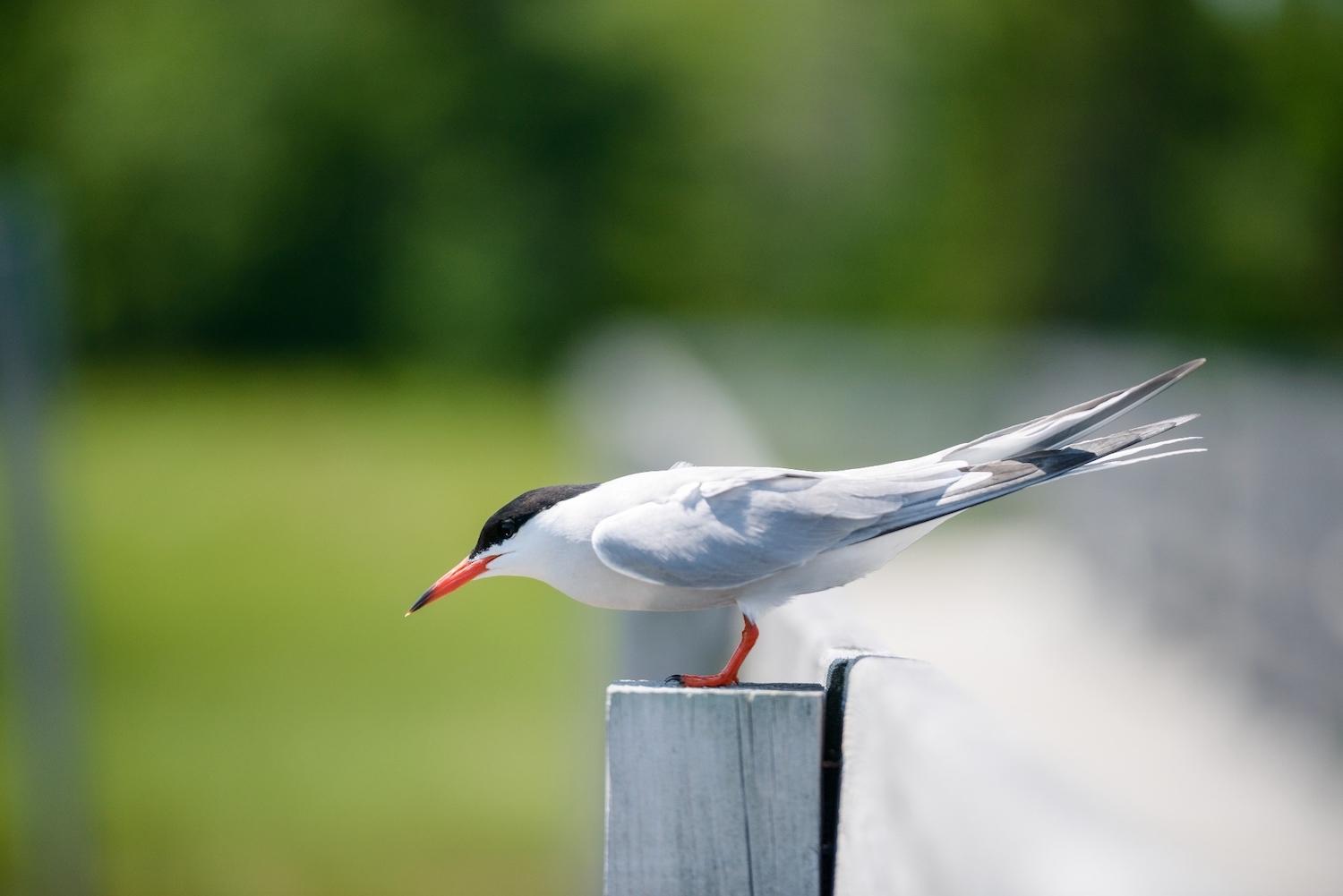
Kouchibouguac National Park draws Canada's largest nesting colony of Common Terns every summer/Parks Canada, Kouchibouguac National Park
A Boat Trip To Canada's Largest Tern Colony
By Jennifer Bain
As we fight our way across Saint-Louis Lagoon against robust winds and under threatening skies, gray seals sporadically pop their hooked-nose “horseheads” up from the swells and stare intently as if to lead the way to Tern Islands.
The winds and currents of Blacklands Gully don’t cooperate as we pass Tern Island 1, but after a detour to explore a larger barrier island called South Kouchibouguac Dune, the weather settles down and allows us to anchor in the shallow tidal water off Tern Island 2.
It should immediately be said that I am stepping ashore with Parks Canada ecologist Daniel Gallant and resource management officer David Mazerolle here at Kouchibouguac National Park on the eastern coast of New Brunswick. As signs planted in the sand warn, this is a marine bird nesting area and access is prohibited Apr. 1 to Sept. 30.
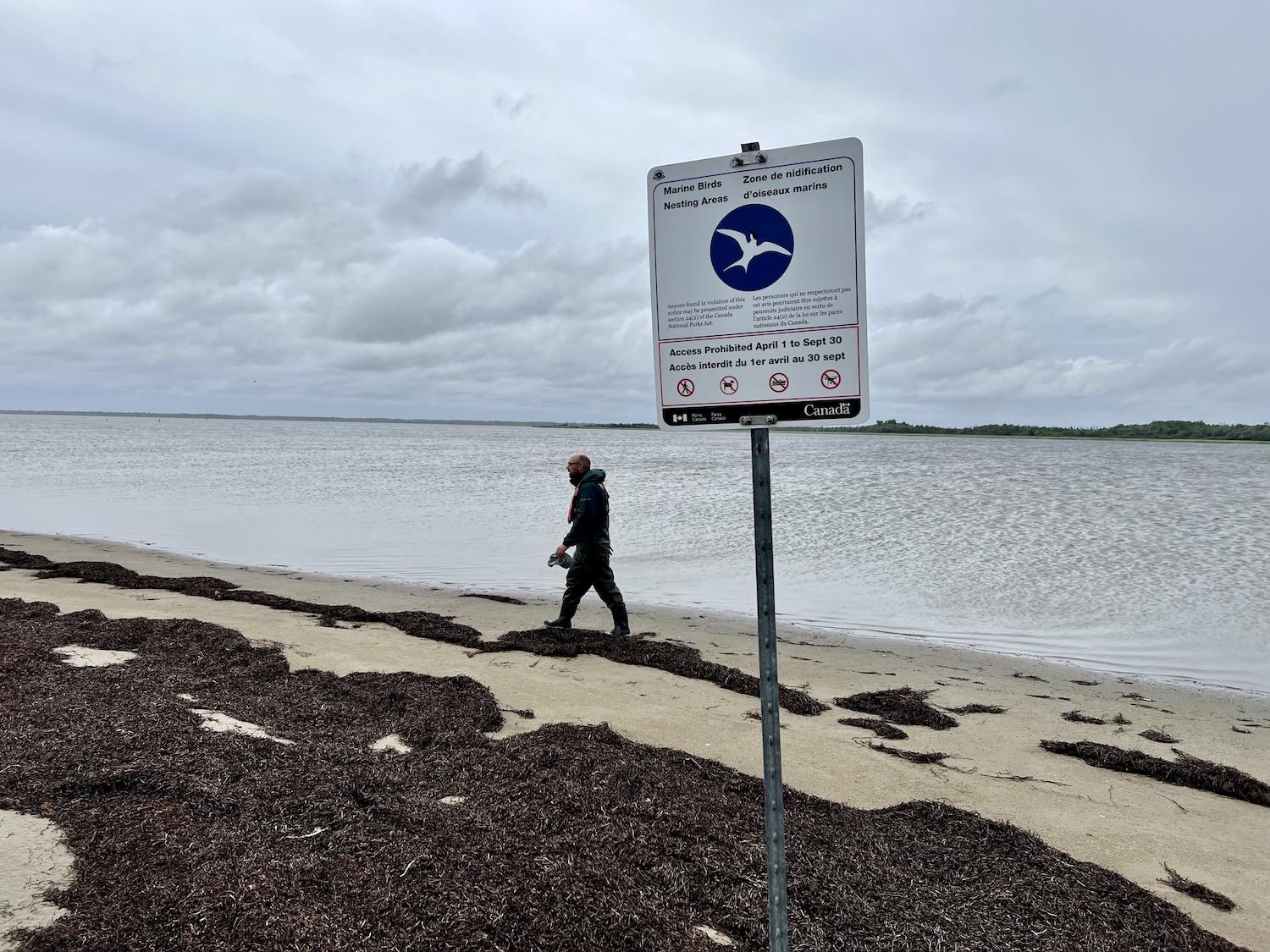
Parks Canada ecologist Daniel Gallant is allowed to be on Tern Island 2, a barrier island that draws nesting Common Terns/Jennifer Bain
That’s because these tiny barrier islands are home to the largest concentration of Common Terns in Canada, and the second (or third) largest colony in North America depending on who you ask and how you measure.
Terns aren’t a species at risk, but thousands of these sociable seabirds with pale gray bodies, black caps and long, angular wings stop here every summer to nest on the ground.
“It’s such a big colony and it's not an insignificant portion of the total Canadian tern population,” explains Mazerolle, a botanist. "So if the colony disappears, if we don't manage it properly, if we're not good stewards — then it will have an impact on the Canadian population."
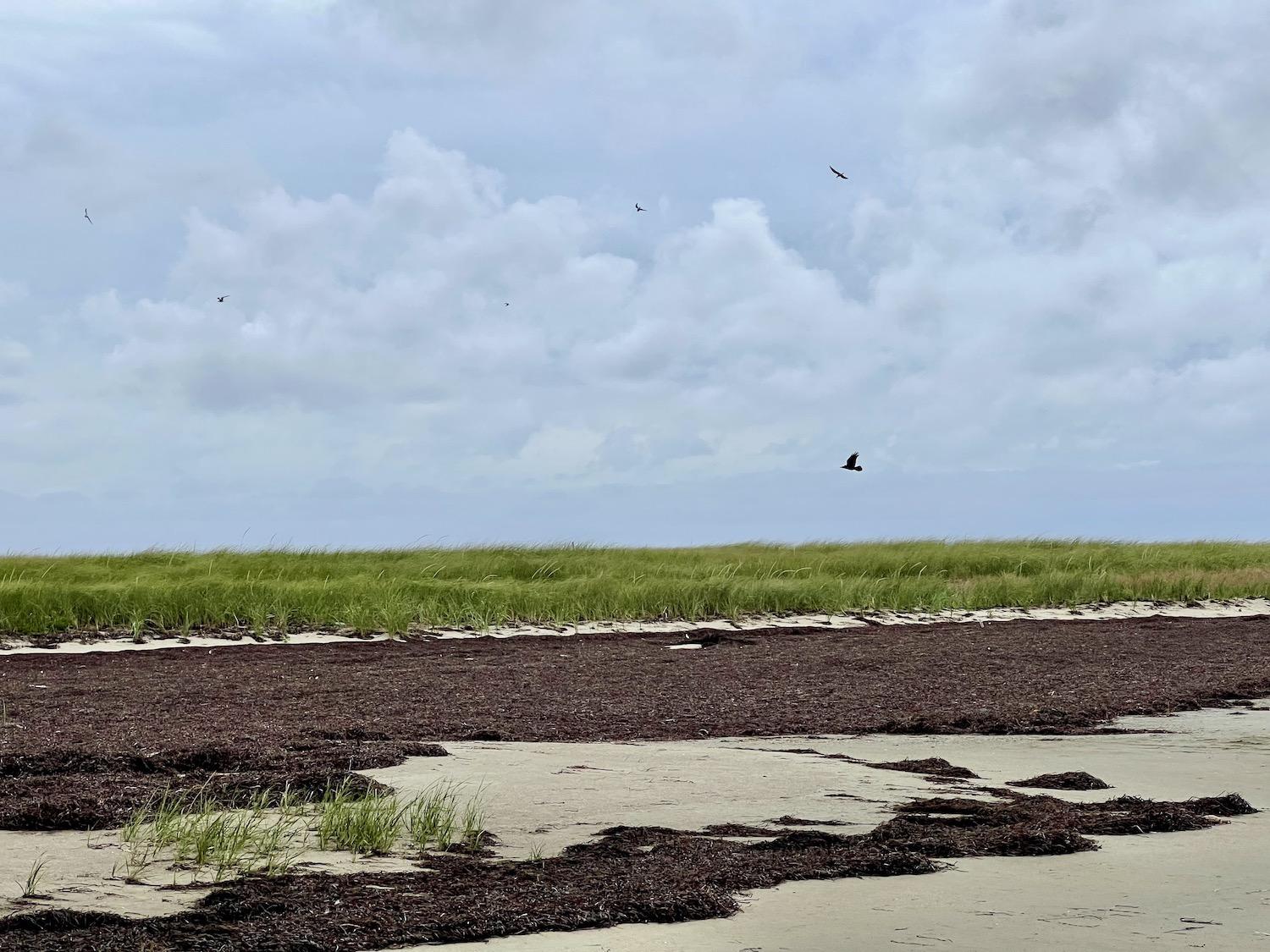
A large bird, possibly a crow, gets the Common Terns of Tern Island 2 all riled up/Jennifer Bain
Terns feed on small fish from the lagoons and along the outer beaches of barrier islands, and they’re considered indicators for the condition of coastal, marine and estuarine ecosystems. They gravitate to islands like this to avoid foxes and other land predators.
We hear the shrill cacophony of the terns before seeing them, after being distracted by a large gathering of gangly Double-crested Cormorants as well as a smattering of Semipalmated Sandpipers feasting on the shore buffet.
The terns are clustered at the opposite end of the island and are swooping and squawking. They’re not mad at us, though, as we quickly realize when a bird of prey — possibly a Northern Harrier — erupts from the foliage and the terns give aerial chase.
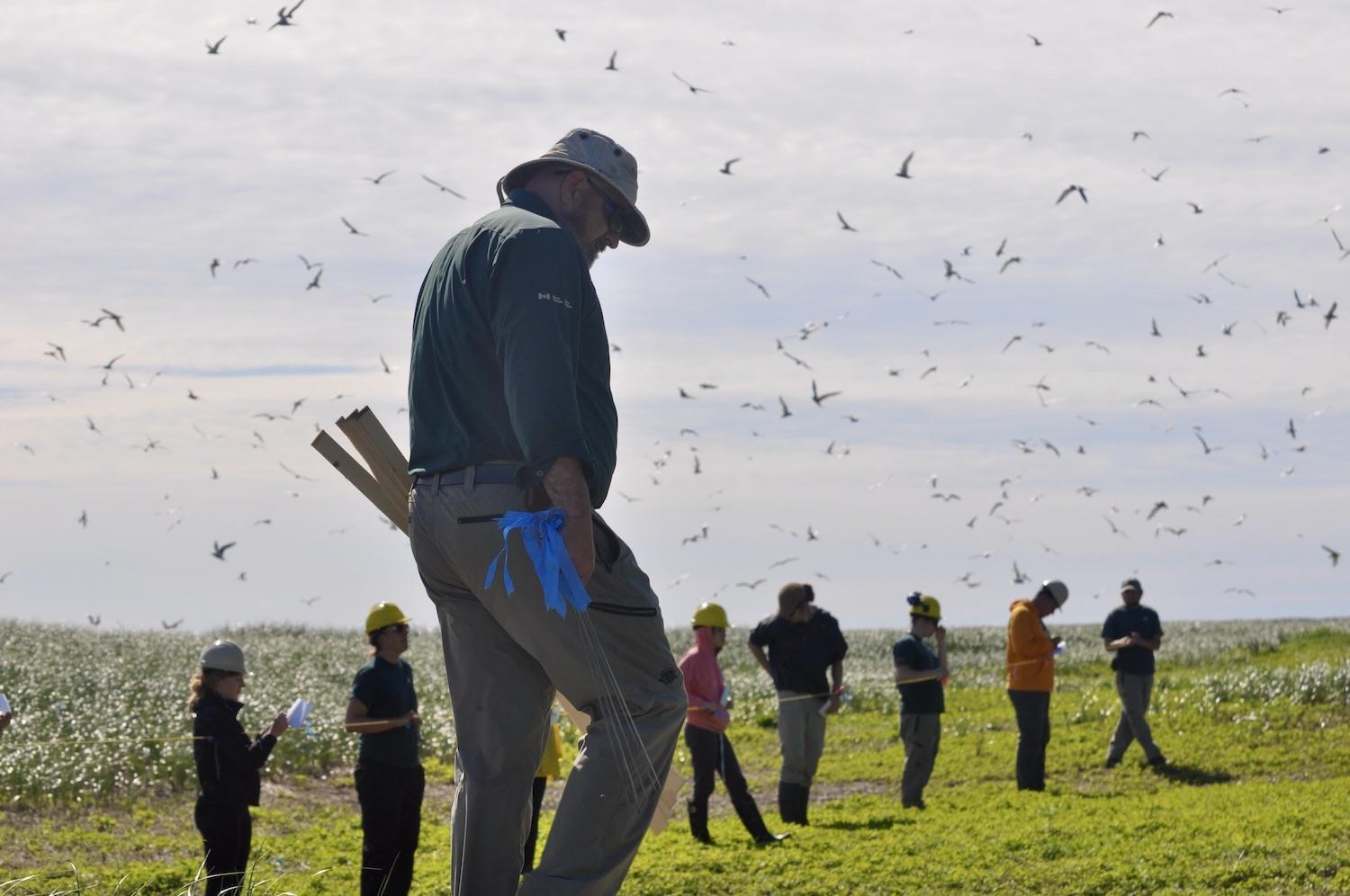
This file photo shows Parks Canada staff and volunteers doing annual monitoring of the Common Tern colony on Tern Islands at the height of nesting season/Alain Clavette
It’s mid-August and the colony is winding down so we aren’t dive-bombed by terns defending their territory, I'm disappointed to realize.
We walk the sandy perimeter of Tern Island 2, which takes barely 15 minutes and is something only employees and researchers usually get to do. Along the way we see scattered white feathers, one tern skull and a surprising number of predated eggs, holes punched in their speckled shells.
Parks Canada usually does colony monitoring here to determine the annual total number of nests and estimate mean clutch size to evaluate long-term breeding population health. That didn’t happen this year because of safety concerns for employees due to an Avian Flu outbreak in Atlantic Canada. But the 2021 nest count was 5,466 nests, so almost 11,000 breeding adults. The mean clutch size (eggs per nests) was 2.23.
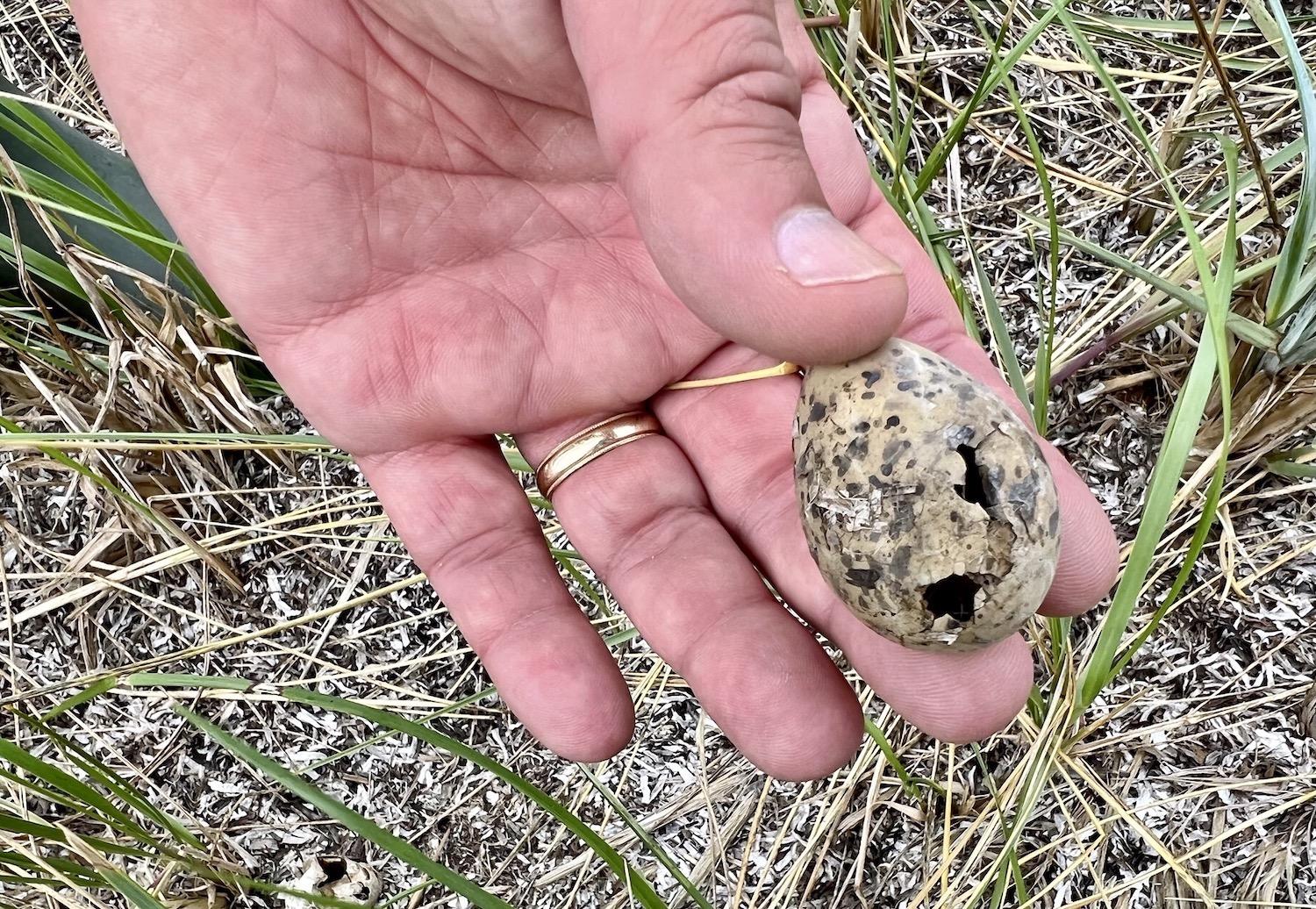
Parks Canada ecologist Daniel Gallant holds a predated tern egg on Tern Island 2/Jennifer Bain
Pronounce it koo-she-boo-gwack or just call it Kouch, Kouchibouguac National Park was established in 1969, appropriating the land of about 1,200 Acadian and English-speaking residents in seven villages — an ongoing saga that is told in great detail in interpretive displays at its visitor reception center.
Kouch is in Mi’kma’ki, the traditional hunting and gathering territory of the Mi’kmaq. The park’s often-mispronounced name is rooted in the Mi’kmaq word Pijeboogwek (or Pigipogoek), which means “river that flows and grows into the forest” or “river of long tides.”
The four-season park on the Northumberland Strait facing Prince Edward Island is prized for its coastal landscapes, sandy beaches, dunes, warm ocean waters and 25-kilometre (15-mile) broken series of barrier dune islands. It also has eight ecosystems and so there are Acadian forests, salt marshes, peat bogs, tidal rivers and freshwater lakes to explore.
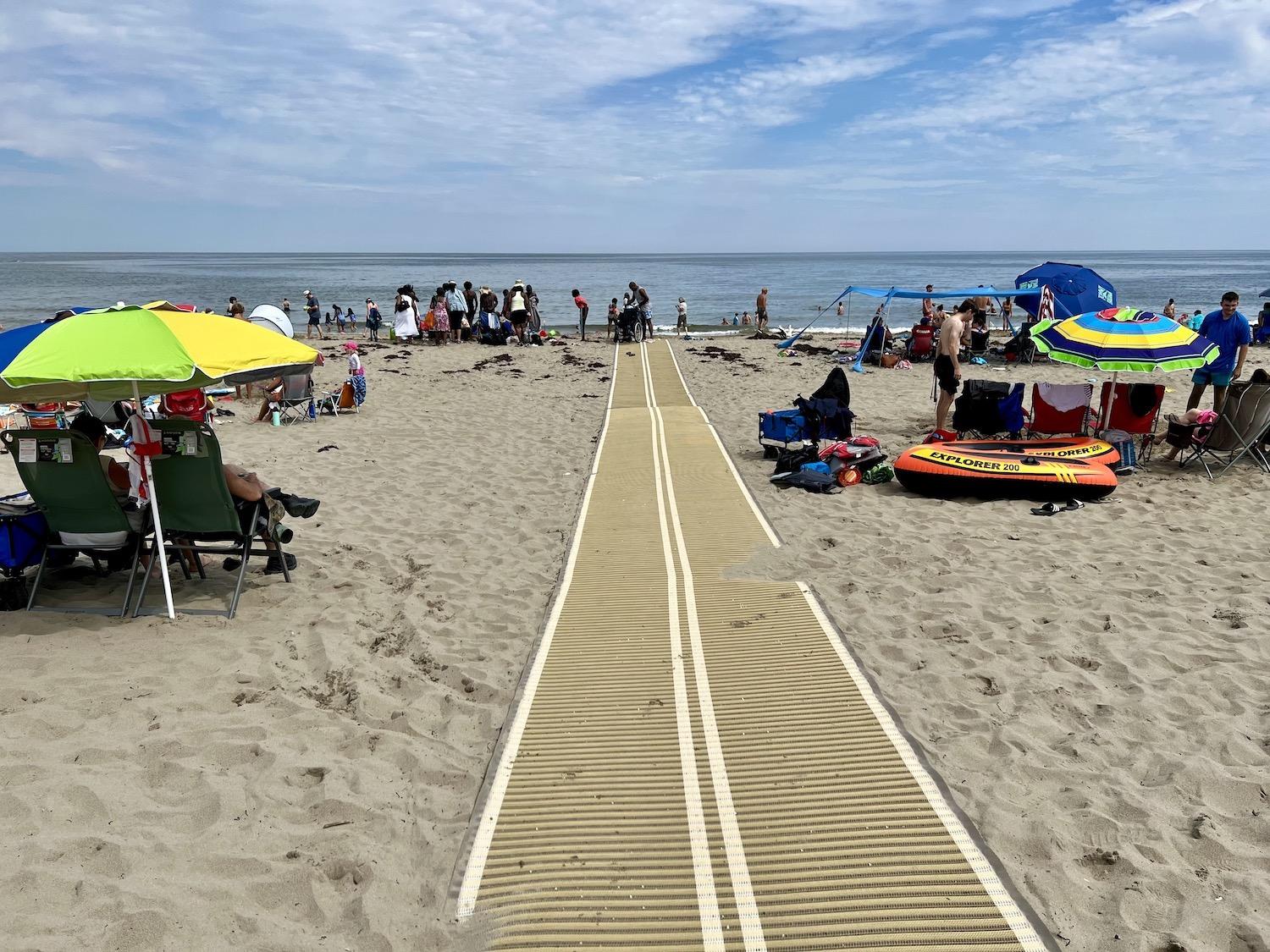
Kellys Beach is a big draw at Kouchibouguac and it has a special mat that allows wheelchairs to move across the sand to the water/Jennifer Bain
Kouch showcases Mi’kmaq and French-speaking Acadian cultures and protects 238 square kilometres (92 square miles) of Maritime Plain natural region and more than 15 species at risk. In 2019 — the last pre-pandemic season — Kouchibouguac drew 226,400 visitors.
This August, I am one of them, basing myself in nearby Miramichi. Entering the park for the first time, I stop at the visitor center and find five Nature Legacy Collection postcards among the free literature. Terns and seals aren’t featured, but there are offerings for four threatened species, starting with the Gulf of St. Lawrence Aster, a salt marsh plant that is finally regenerating in the park after disappearing in 2015 and being reintroduced. It grows in moist, sandy soil in coastal habitats but doesn’t deal well with frequent exposure to salt, drought or other species. Parks Canada feels the fragile aster’s fate is tied to how sea-level rise and climate change will unfold in this region.
Another postcard details how Red Knot Rufas rest and feed on shores here every summer as they migrate from Argentina to the Canadian Arctic. I read how nocturnal Little Brown Bats appreciate the fact Kouchibouguac has been a Dark Sky Preserve since 2009, and how the park has been caring for nesting Piping Plovers for more than 35 years. This year, Kouch protected nine nests and saw 10 chicks hatch.
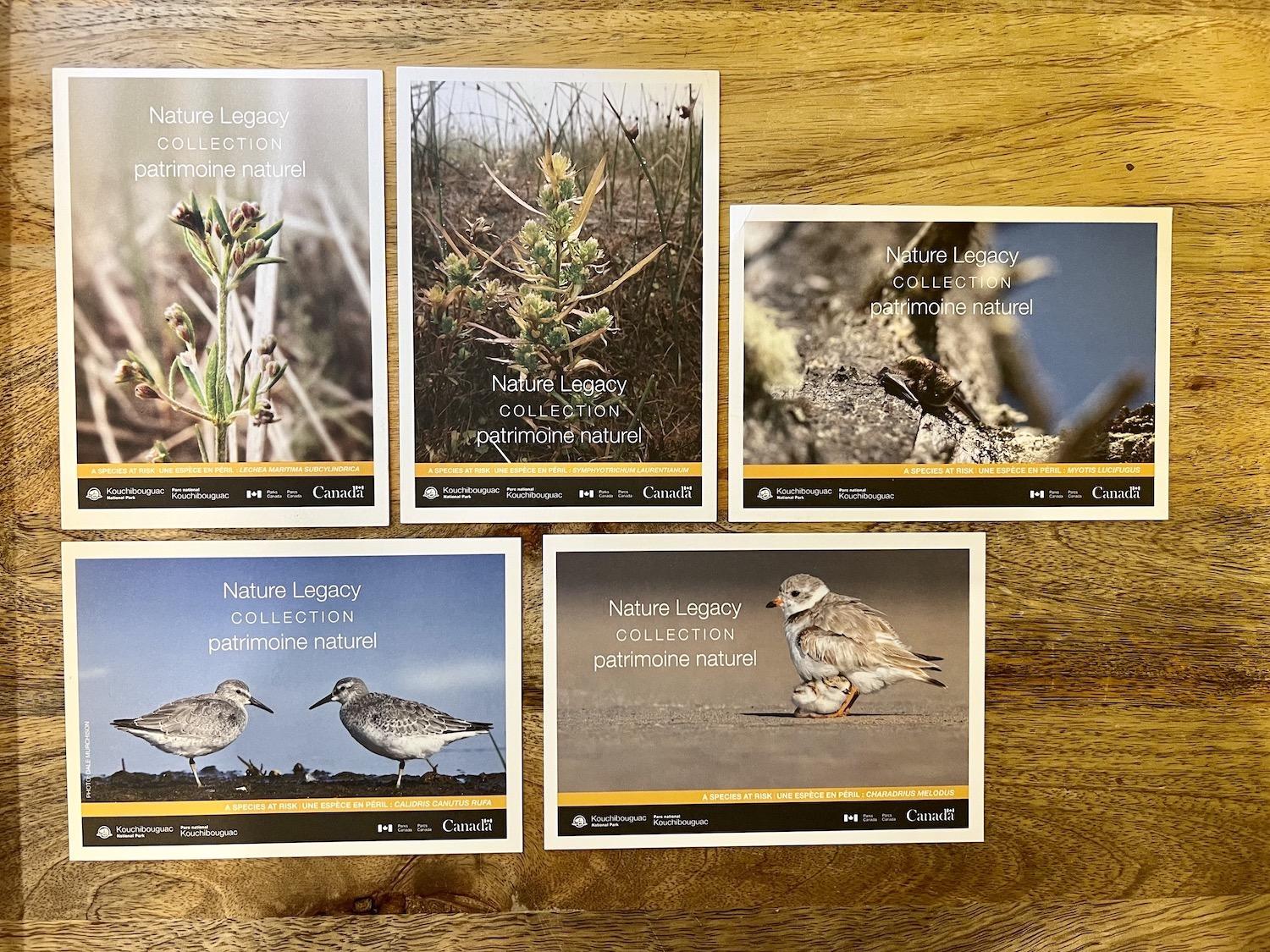
Free postcards at Kouchibouguac detail species at risk/Jennifer Bain
The fifth card, for Beach Pinweed (Lechea maritima), a species of special concern, intrigues me. It says 65 per cent of the world’s population of the subcylindrical variety can be found at Kouch’s dunes, and so I ask Gallant and Mazerolle to lead me to the plant in real life, given that the weather has scuttled a surprise side trip see softshell clam "fishing" in action.
I meet the men at Cap Saint-Louis, one of two commercial wharves within the park, and we set out cautiously in dubious weather in their Carolina-style skiff, knowing we may have to turn back at any moment. The shallow lagoon is full of Common Eelgrass and we have to stop several times when it wraps around our motor.
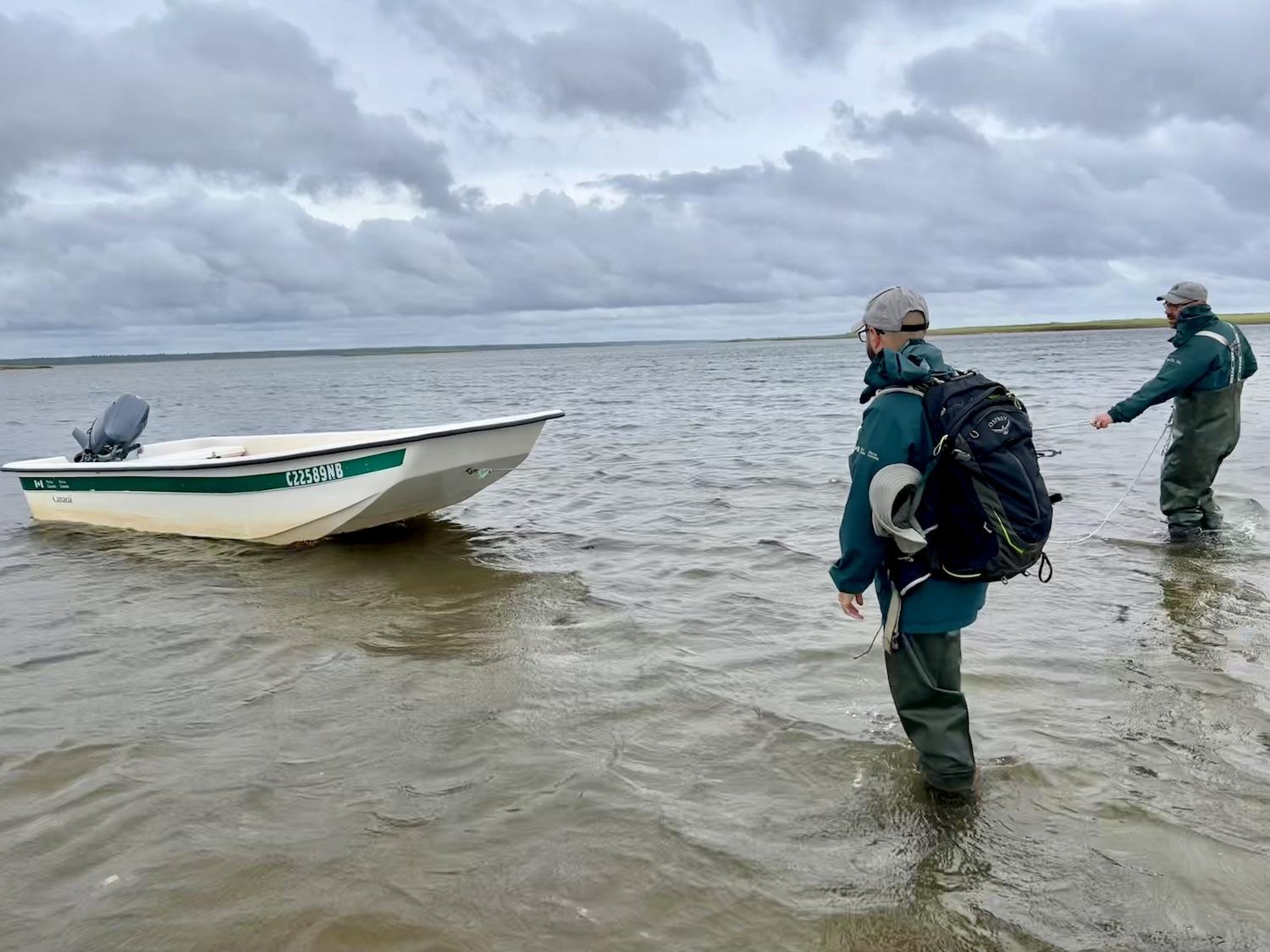
Parks Canada's David Mazerolle, left, and Daniel Gallant, right, anchor their boat in the shallow Saint-Louis Lagoon/Jennifer Bain
Until the pandemic, Kouch offered guided voyageur canoe trips out past Tern Islands to see the seals, which can number up to 1,000 in the summer and congregate at the end of South Kouchibouguac Dune. These lengthy and challenging journeys in a communal canoe are on hiatus while Parks Canada rethinks the program.
There is a public way to do something similar to what I’m doing today, although it involves a 16-kilometre (10-mile) coastal hike.
Drive to the Kellys Beach parking lot and walk the spectacular, lengthy boardwalk over the lagoon to the ocean-facing beach on the South Kouchibouguac Dune. Turn right and walk along the shore to the tip of the island where the seals hang out, being mindful if you pass restricted areas where Piping Plovers nest. After getting your fill of seals, cut across to the lagoon-facing side of the island and train your binoculars or zoom lens on Tern Islands. When you're done, hike back to Kellys Beach.
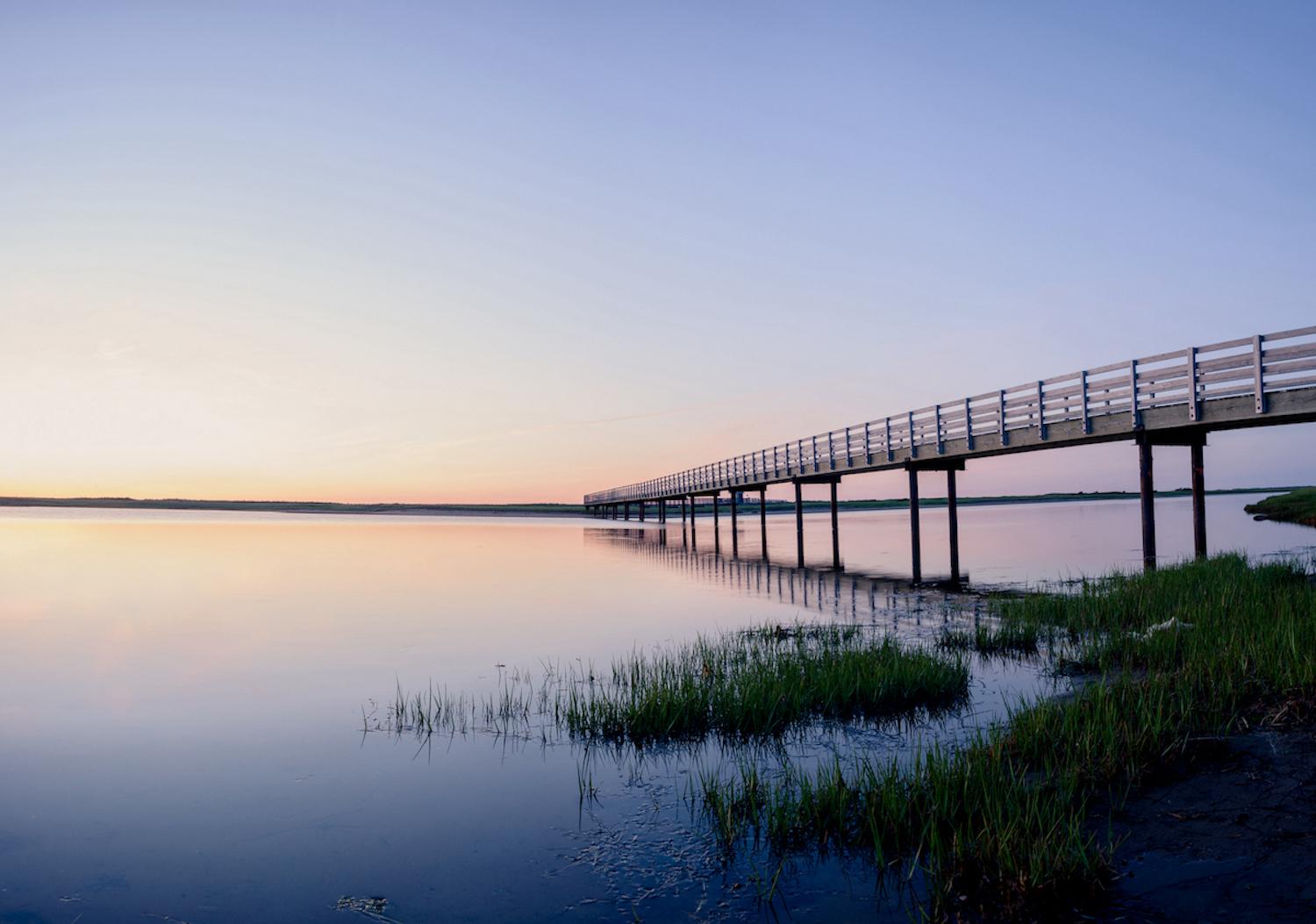
The 1.2-kilometre (0.7-mile) boardwalk over a lagoon to Kellys Beach is one of the iconic features of Kouchibouguac National Park/Parks Canada
It feels like cheating to arrive at the tip of the barrier island somewhat easily and quickly by boat, but when we carefully cross through American Beachgrass (marram grass) to the ocean side hoping for the spectacle of an entire seal colony, all we see are a few dozen seals bobbing merrily in the crashing waves near shore.
“It’s surprising to see them in the breaking waves,” says Gallant.
The winds are so fierce here that we take a moment to gratefully acknowledge how this island dune, as narrow as it may be, really shelters the lagoon.
As Kouchibouguac’s 2021 management plan notes, the park’s vulnerable marine and coastal areas will surely face significant pressure in the coming decades. Key threats include visitors who come by both land and sea, marine and terrestrial alien invasive species, and the growing popularity of the recreational softshell crab and brook trout fishery. As well, Kouch is “sensitive to climate change, particularly gradual sea level rise.” Annual erosion rates on barrier island shorelines are already at an average of 1.8 metres (5.9 feet) due to storm surges.
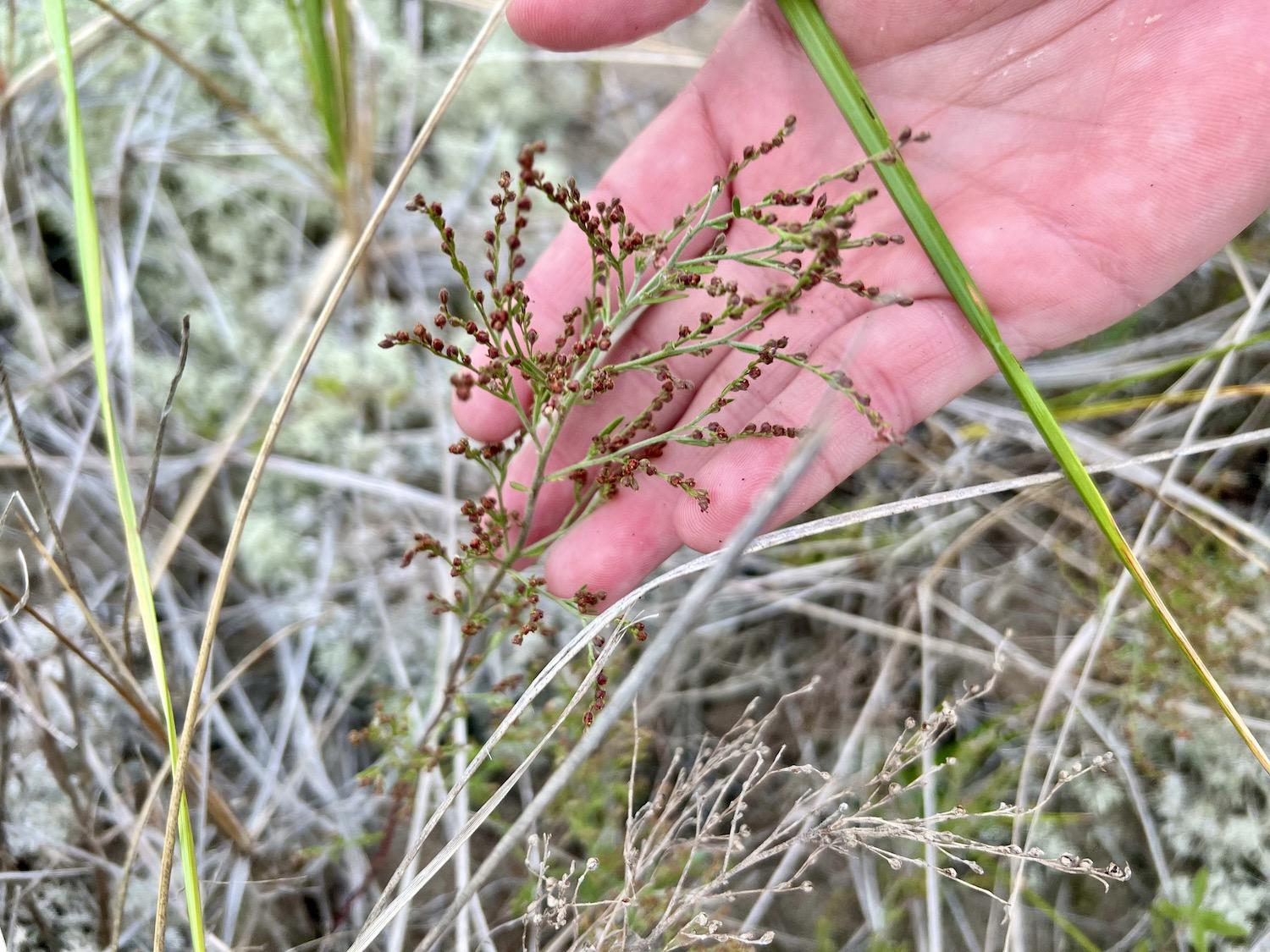
Beach Pinweed is subtle and grows near the ground on dunes so is easily missed/Jennifer Bain
As we return to our boat, the lagoon winds seem calm and so we decide to motor down to one more spot on South Kouchibouguac Dune where Beach Pinweed grows.
Back on shore, we walk the lushly vegetated dune, eyes trained on the ground. It’s a tense seven minutes until we find patches of the easily overlooked herbaceous perennial. The species has what Mazerolle calls "a subtle grandeur." As Nature Conservancy Canada describes it, "it grows from a dense cluster if hairy leaves that remains close to the ground. By mid-summer, 20- to 35-centimetre stalks covered with small, reddish-brown flowers shoot up." Here, some clusters are a decade old.
Beach Pinweed is always found here near Beach Heather and Reindeer Lichen — scientists don't know why. And while the main species grows widely along the Eastern Seaboard down to North Carolina, the Gulf of St. Lawrence Beach Pinweed (Lechea maritima var. subcylindrica) variety is rare and is found in Canada only on New Brunswick’s eastern coast and on Prince Edward Island’s northern shore. Kouch now has about half of this variety, down from the 65 per cent noted on the postcards.
“It's a species at risk, we're the people responsible, and it's on our shoulders to take as good care as we can,” Mazerolle explains. “Unfortunately, the biggest threats are things we can't control — severe storms and things related to climate change, like increase frequency of storms, increased severity. And then also the fact that we no longer have ice along the coast where we used to during winters. So the winter storms are not being buffered by ice and snow like they used to.”
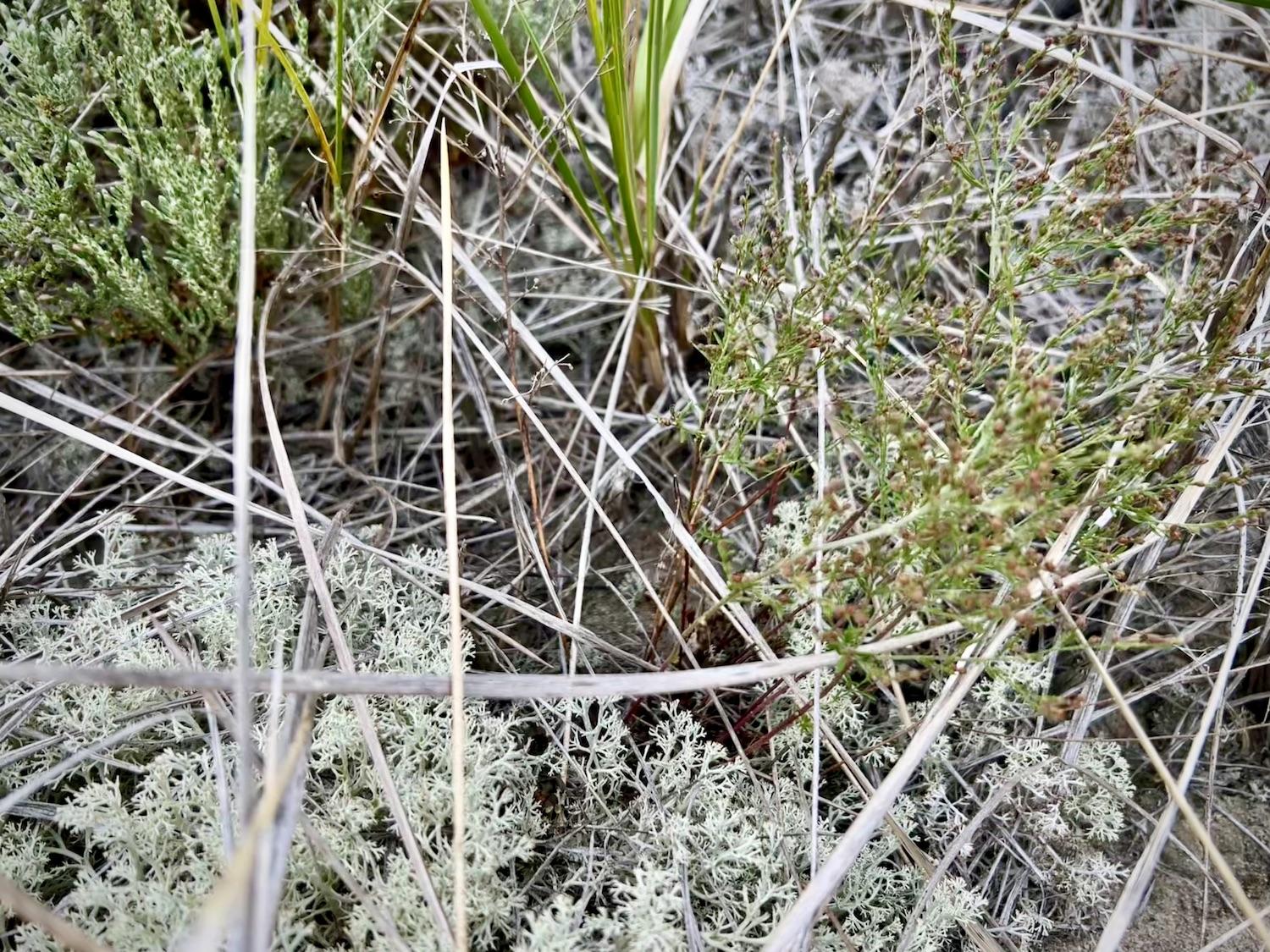
Beach Pinweed, right, always grows on Kouchibouguac's dunes near Beach Heather, left, and Caribou Lichen, bottom/Jennifer Bain
Beach Pinweed only grows in sandy but vegetated coastal dunes that are sheltered from waves and flooding when there's a storm surge.
"Stable areas," stresses Gallant.
"It's weird to say stable dune ecosystem because dunes moves around — they're dynamic," adds Mazerolle. "But these are plants that really need the most stable parts of these dunes."
Parks Canada has already documented a significant decline in this Beach Pinweed population and because Kouchibouguac has such a big chunk of the world's population, the decline has an impact on the global status of the species. "This is a plant whose status is probably going to be reassessed in the next couple of years," predicts Mazerolle. "And its status is most likely going to change from what it is now — which is special concern — to threatened or worse."
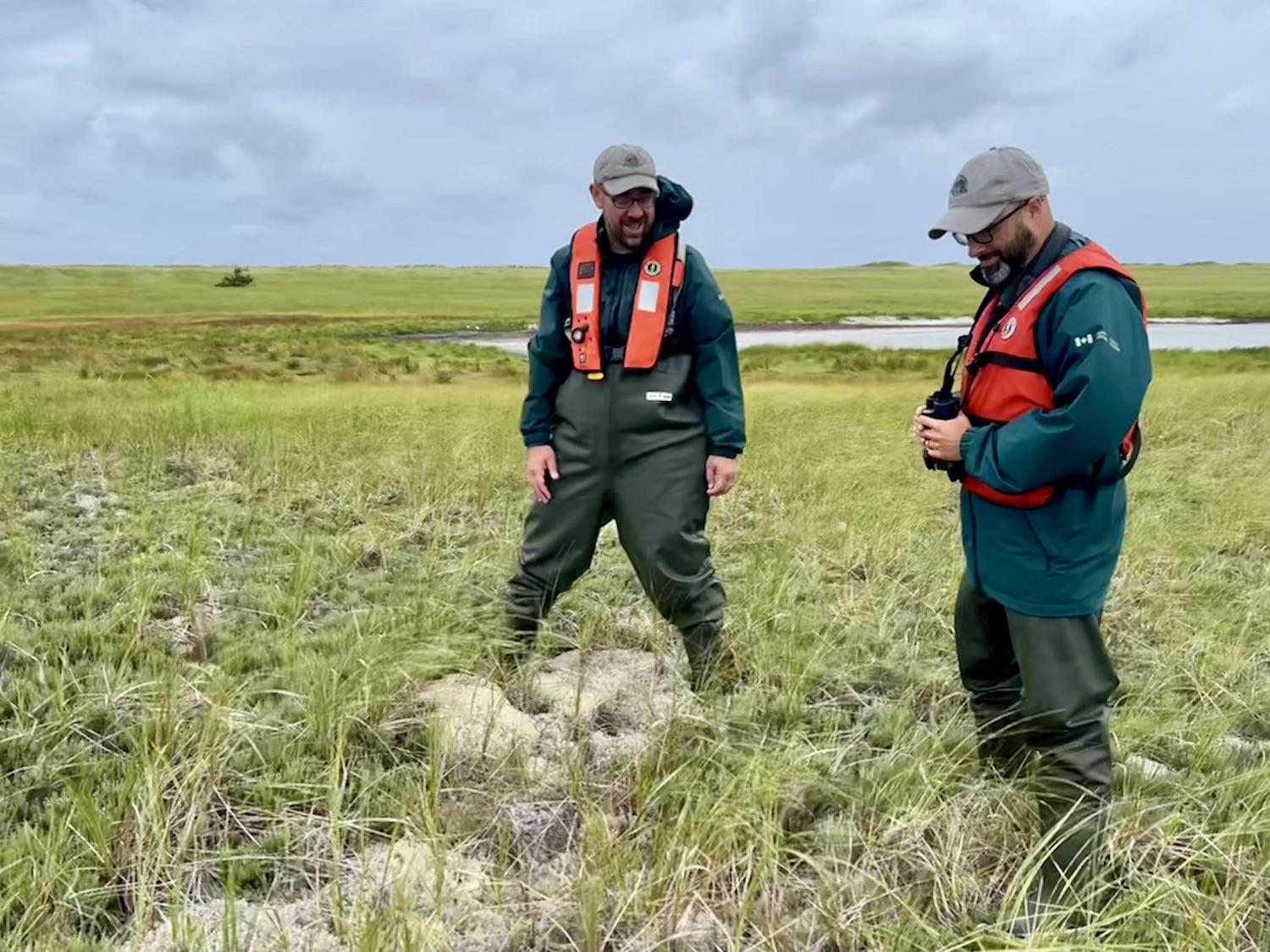
Parks Canada's Daniel Gallant, left, and David Mazerolle, right, find Beach Pinweed on the vegetated South Kouchibouguac Dune/Jennifer Bain
So why exactly does Beach Pinweed matter?
“Those are always philosophical questions, and there are a lot of factors,” Mazerolle replies. “The rarest species are often the least understood species, because we have less of an opportunity to study them completely. So we often don't really know exactly what role they play in the ecosystem." But, he continues, "every plant has a right to exist and for this plant there are big questions, big things that we don’t know about its ecology. It’s a good species to use as an indicator of how our dune systems are doing. A severe decline would probably indicate that the dunes are moving faster, changing faster, than they used to 50 or 100 years ago.”
What the Beach Pinweed needs, the men agree, is a couple of master's students working on their theses to figure out what this plant needs to germinate. Parks Canada has already collected seeds for research purposes, and hopes to collect more for conservation projects.
"Most likely what we're going to see is the habitat of this dune is going to move around," says Mazerolle. "But if this plant can't keep up and it disappears, then we need to know what we need to do to grow this thing." For that kind of work, Parks Canada hopes to partner with a university. A recent funding request was turned down, but it will try again.
"We find the problem and then we go find the people to work with us on the problem," says Gallant, who is a team leader with Parks Canada and happy for the chance to get out of the office today.
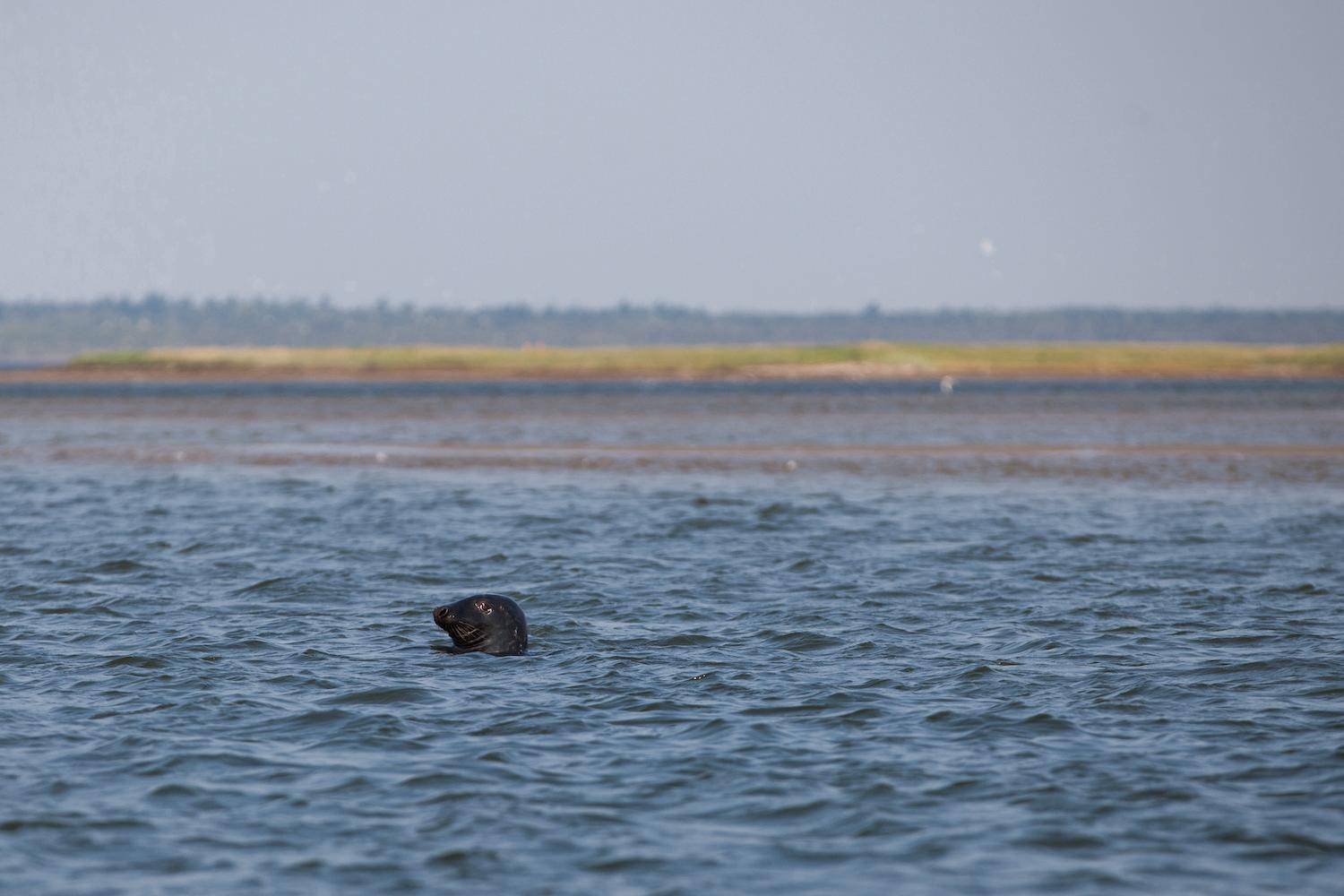
Gray seals like to sit vertically with their heads poking out of the water/Parks Canada
And with that declaration, it's time to make our way back to the boat — chatting about a rare forested section of dune and stopping to admire the delicate pink flowers of provincially rare American Germander.
In just a few short hours, I've seen Kouchibouguac's famous terns and seals (albeit in small numbers), been guided across two areas of the same dune, seen several stubby and wind-battered trees but not a forest, and been introduced to an under-the-radar dune plant that clearly deserves more champions.
The ride back to the wharf is relatively painless, the wind at our backs pushing us along, but I'm not dressed as sensibly as Gallant and Mazerolle — who sport chest waders — and a chill is setting in from all the wind, waves and drizzle on this tempestuous summer day.
The gray seals that escorted us out have all but disappeared, or perhaps they're less curious about a boat load of people leaving their turf instead of entering it. Only a single seal pops its head up from the turbulent water and shoots us an inscrutable stare before diving back into the lagoon in search of its next meal.

Add comment